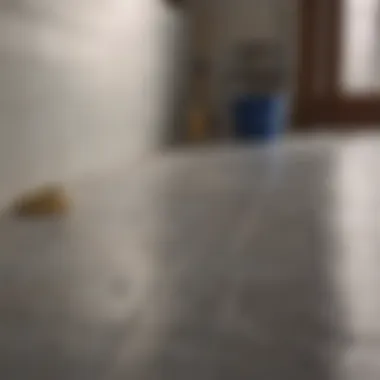Effective Methods for Cleaning Bathroom Floor Grout


Intro
Maintaining the cleanliness of bathroom floor grout is vital for the aesthetics and hygiene of your home. Over time, grout can become discolored due to various factors, including soap scum, mold, and mineral deposits from hard water. Understanding how these elements affect your grout can lead to more effective cleaning methods.
This article will provide an in-depth exploration of effective strategies for cleaning bathroom floor grout. We will discuss the primary causes of grout discoloration, essential cleaning supplies, and comprehensive step-by-step techniques. Additionally, we will offer preventative measures to ensure the continued beauty of your bathroom. The goal is to arm homeowners with practical knowledge, making their bathrooms not only clean but also visually appealing and inviting.
Design Inspirations
When addressing cleaning and maintenance of bathroom floor grout, it's essential to consider the overall design and style of your space. The choice of materials, colors, and layout can significantly influence how much maintenance your grout requires and how effectively you can clean it.
Modern vs. Traditional Bath and Bedroom Styles
Modern bathrooms often feature sleek lines and minimalistic designs. This style usually incorporates larger tiles with less grout, which can reduce the amount of cleaning needed. On the other hand, traditional bathrooms might use smaller tiles with intricate patterns, leading to more grout surface area and potential discoloration. It requires more regular attention.
Color Palettes and Textures
The choice of grout color can impact how easily dirt and stains are visible. Light-colored grout tends to show dirt more readily, while darker shades can better disguise stains. However, darker grout may itself require specific cleaning techniques to sustain its appearance. The texture of tiles also plays a role; textured surfaces may trap dirt and grime more than smooth tiles, complicating the cleaning process.
"Choosing the right grout can not only enhance the design aesthetic but also simplify maintenance efforts."
By understanding these design elements, homeowners can not only keep grout clean but also maintain the overall beauty of their bathrooms more effectively.
Understanding Bathroom Floor Grout
To maintain a clean and appealing bathroom, it is essential to understand bathroom floor grout. Grout serves as the adhesion between tiles, sealing gaps and preventing water and dirt from penetrating beneath. Understanding its role is crucial to keep the bathroom looking pristine.
Grout is not just a filler; it can affect the aesthetics and longevity of your flooring. If not cared for, it can become a breeding ground for mold and mildew, posing health risks. Therefore, educating oneself about grout types, issues, and maintenance strategies is beneficial for any homeowner.
This section delves into the components of grout, the different types useful in bathrooms, and some prevalent problems. By comprehending these aspects, homeowners can make informed decisions about cleaning methods and ongoing maintenance to prolong the life and appearance of their tile floors.
What is Grout?
Grout is a substance used to fill the spaces or joints between tiles. It comprises a mixture of water, cement, and sometimes pigments to match tile color. Its main function is to stabilize tiles, preventing movement and providing a finished appearance to tiled surfaces.
While grout is usually waterproof, this characteristic can diminish over time due to wear and tear. Regular maintenance is necessary to ensure it continues to perform effectively.
Types of Grout Used in Bathrooms
Understanding the types of grout available is fundamental for selecting the appropriate one for bathroom use. Each type has unique properties that make it suitable for different settings.
Epoxy Grout
Epoxy grout is a durable option known for its water and stain resistance. It is often favored in areas where high moisture is present, making it perfect for showers and tub surrounds. The key characteristic of epoxy grout is its ability to resist mold and mildew growth, critical in a humid environment like a bathroom.
Its unique feature is the epoxy resin that binds it. This results in a tough bond that can withstand significant wear. However, epoxy grout can be more challenging to apply, often requiring a professional for optimal results.
Cementitious Grout
Cementitious grout is the most commonly used type. It is composed primarily of cement, water, and sand. It is easy to work with and is often chosen for its affordability. A notable aspect of cementitious grout is its versatility, making it suitable for various applications.
However, this type can be prone to staining and does not resist moisture as effectively as epoxy grout. Therefore, homeowners should consider sealing it regularly to maintain its appearance.
Furan Grout
Furan grout is a less common but specialized type. Typically, it is used in commercial settings due to its chemical resistance. The key characteristic of furan grout is its strong bond and incredible durability, which makes it suitable for areas exposed to harsh chemicals.
Its unique feature is that it can bond to moist surfaces, allowing it to be used in challenging environments. However, it can be difficult to work with and may require skilled applicators, which can increase overall costs.


Common Grout Problems
Understanding common issues with grout can help homeowners address them promptly, thereby ensuring the upkeep of their bathroom tiles.
Discoloration
Discoloration is a prevalent problem that can arise from various factors such as moisture, dirt accumulation, and cleaning products. Over time, grout can lose its original color, leading to an unsightly appearance. This issue affects the overall look of the bathroom, making it seem less clean.
Addressing discoloration often involves deep cleaning methods or even re-grouting if the stains are too entrenched.
Cracking
Cracking in grout can occur due to improper installation or shifts in the foundation of the building. When grout cracks, it not only looks bad, but it can also let moisture penetrate, leading to more significant problems like mold growth or tile movement. Regular inspections can help detect cracking early, allowing for repairs before they escalate.
Mold Growth
Mold growth is a significant concern in bathrooms, particularly if grout is not properly sealed or maintained. Mold thrives in damp environments, and if grout is compromised, it can create serious hygiene issues. Keeping grout clean and ensuring proper ventilation in the bathroom can significantly reduce the risk of mold exposure.
Factors Leading to Grout Discoloration
Grout discoloration is a common concern among homeowners, particularly in the bathroom where moisture levels are high. Understanding the factors that contribute to grout discoloration is essential not only for addressing existing issues but also for preventing future problems. Discolored grout can detract from the visual appeal of your bathroom and compromise the overall cleanliness of the space. The following subsections will delve into the key factors that lead to grout discoloration, which include water damage, soap residue, and hard water stains.
Water Damage
Water damage is arguably the most significant contributor to grout discoloration. Excessive moisture can seep into the grout lines, leading to a damp environment. This creates the ideal conditions for mold and mildew to thrive, which can cause unsightly black or green stains.
To mitigate water damage, it is crucial to check for leaks around sinks, toilets, and tubs. Repairing any leaks quickly will help maintain the integrity of the grout. Moreover, ensuring proper ventilation in the bathroom can help reduce moisture levels. A simple exhaust fan can significantly decrease humidity, helping to keep grout color intact.
Soap Residue
Soap residue is another common factor leading to grout discoloration. Many commercial soaps and body washes are rich in oils and various additives. When these products are used in the shower or bath, their residue can accumulate in the grout lines. Over time, this buildup can manifest as dull and discolored grout.
Regular cleaning can help combat soap residue. Using a mild acid-based cleaner can effectively break down soap scum. Additionally, opting for products that are low in soap content may also assist in reducing the rate of accumulation.
Hard Water Stains
Hard water refers to water that contains a high concentration of dissolved minerals, such as calcium and magnesium. When hard water evaporates, it leaves behind mineral deposits, which can accumulate and cause unsightly stains in grout. These stains may appear as white or chalky spots, making the grout look dirty.
Installing a water softener can significantly reduce hard water issues in your household. This not only aids in preventing grout discoloration but also benefits other fixtures and appliances by reducing mineral buildup. Regular cleaning with a solution specifically designed for hard water stains can help maintain the appearance of your grout.
"Understanding these fundamental factors enables homeowners to take proactive measures in protecting their bathrooms from the effects of grout discoloration."
By recognizing the implications of water damage, soap residue, and hard water stains, homeowners can enjoy a cleaner, more appealing bathroom environment.
Essential Tools and Supplies for Cleaning Grout
Cleaning grout effectively requires the right tools and supplies. The selection of appropriate materials can significantly impact the efficiency and success of the cleaning process. Homeowners should consider the various options available to ensure they are equipped for the task. Having the correct tools not only facilitates easier cleaning but also helps maintain grout's integrity and appearance over time.
Recommended Cleaning Solutions
Commercial Grout Cleaners
Commercial grout cleaners are specialized solutions designed to tackle deep-seated stains and grime. These products often contain strong chemical agents that can penetrate tough stains. The key characteristic of commercial cleaners is their concentrated formula, which may yield faster results compared to DIY methods.
A notable advantage of commercial grout cleaners is their effectiveness. They are specifically formulated to break down different types of dirt, including soap scum and mildew. However, some users express concerns about the potential harshness of chemicals in these products. It is vital to follow instructions carefully to minimize any risks.
Natural Cleaning Solutions


On the other hand, natural cleaning solutions offer an eco-friendly alternative. Often composed of vinegar or baking soda, these solutions are gentle yet effective on light stains. Their key characteristic is the use of non-toxic ingredients, making them safe for families and pets.
One unique feature of natural solutions is their versatility; they can also be used for cleaning other household surfaces. However, their effectiveness may be limited against stubborn stains. Users may need to apply more elbow grease or repeat the process to achieve desired results.
Cleaning Equipment
Toothbrush
A simple toothbrush can be an undervalued tool when cleaning grout. Its small bristles can get into narrow grout lines better than larger brushes. The key characteristic of a toothbrush is its ability to provide precise and controlled scrubbing. This makes it a favored choice for detail cleaning in hard-to-reach areas.
The unique feature of using a toothbrush is its accessibility. Most households already own one, and it requires no additional expense. However, it may not be the most efficient option for larger areas, as it can be time-consuming.
Scrub Brush
A scrub brush is a more robust option for cleaning grout. Its wider surface area allows for covering larger sections of grout more quickly. The key characteristic here is the sturdiness of the brush, which can handle tougher scrubbing without losing shape.
A scrub brush's unique feature is its ability to engage with a variety of cleaning solutions. This equipment can be used alongside both commercial and natural cleaners, enhancing its versatility. However, depending on the brush’s bristle strength, it might cause wear on more delicate grout finishes.
Steam Cleaner
The steam cleaner is a more advanced cleaning tool that utilizes high-temperature steam to sanitize grout. The key characteristic of a steam cleaner is its ability to loosen dirt and grime without chemicals. This is an appealing option for those who prefer chemical-free cleaning.
One of the prominent advantages of using a steam cleaner is its ability to cover large areas quickly, saving time and effort. Its unique feature is the capability to kill bacteria and mold, thus providing a deeper clean. However, the initial investment for a good steam cleaner may be higher compared to other cleaning tools.
Step-by-Step Grout Cleaning Techniques
Cleaning bathroom floor grout requires an organized approach. Each step contributes to the effectiveness of the overall cleaning process, ensuring that your grout not only looks good but also lasts longer. Grout cleaning is crucial for maintaining not just aesthetics but also hygiene in bathrooms, where moisture can easily contribute to mold and bacteria growth. This section outlines a systematic method for achieving clean and well-maintained grout.
Pre-Treatment Assessment
Before diving into the cleaning process, a pre-treatment assessment is essential. This stage involves evaluating the condition of the grout. Look for any discoloration, cracks, or signs of mold. Identifying specific problems allows you to choose the right cleaning solution and technique. If you find extensive damage, consider consulting a professional. Here are some aspects to check:
- Level of dirt: Assess how dirty the grout lines are. Some lines may need a deeper clean than others.
- Type of grout: Determine whether your grout is epoxy, cementitious, or furan. This information can guide product selection.
- Moisture levels: Check for moisture issues that could affect cleaning. High humidity can lead to mold growth, requiring special attention.
Applying the Cleaning Solution
After assessment, it is time to apply the cleaning solution. Depending on the type of grout and the degree of staining, select suitable products. Commercial grout cleaners are effective, but natural solutions like baking soda and vinegar can be helpful too. Knowing how to apply the solution correctly is vital for effectiveness. Follow these steps:
- Dilute the cleaner if necessary as per the manufacturer’s instructions.
- Evenly distribute the solution on the grout lines using a spray bottle or a sponge.
- Allow it to sit for the recommended time. This helps lift stains and dirt.
Scrubbing the Grout
Once the cleaner has had time to penetrate the grime, it’s time to scrub. This step may demand some elbow grease but is crucial for a thorough clean. Use a soft-bristle scrub brush or an old toothbrush to avoid damaging the grout. Here’s how to proceed:
- Start with one section at a time to ensure you don’t overlook any areas.
- Use circular motions to effectively work the cleaner into the grout.
- Focus on heavily stained areas until the grime visibly lifts. Persistent stains may require an additional application of the cleaning solution.
Rinsing and Drying
The final step in the grout cleaning process is rinsing and drying. Rinsing is important to remove any remaining cleaning solution and loosened grime. Here’s how to do it:
- Use a mop or soft cloth to wipe away the cleaner. Rinse frequently in clean water to avoid redistributing dirt.
- After rinsing, allow the area to air dry. If possible, improve ventilation by opening windows or using a fan.
- Keep the floor clean until completely dry. This can help avoid new stains.
Important Note: Always check manufacturer guidelines before using any products to ensure compatibility with your specific grout type.
By following these structured cleaning techniques, homeowners can achieve a noticeable improvement in their bathroom grout's appearance. These steps not only enhance visual appeal but also contribute to a healthier bathroom environment.
Preventative Measures for Maintaining Grout


Maintaining the appearance and integrity of bathroom floor grout is crucial in prolonging its lifespan. Preventative measures help stop issues before they arise. Effective grout care enhances the aesthetic appeal of a bathroom and reduces the need for frequent, intensive cleaning. A strategic approach can save time and resources while ensuring a clean and healthy environment.
Regular Cleaning Routine
Implementing a regular cleaning routine is essential in keeping grout looking fresh. Set a schedule that fits your lifestyle, whether that is weekly or bi-weekly. Use a mild cleaning solution mixed with warm water. A gentle scrub with a soft bristle brush can remove surface dirt and stains.
Additionally, quick clean-ups after spills can further prevent staining. Regular vacuuming or sweeping of the floor helps remove crumbs and debris that can trap moisture. By maintaining this habit, you may not need extensive cleaning sessions later on.
Sealing Grout Lines
Sealing grout lines is a vital step in protecting the grout from staining and moisture. A proper seal helps keep the grout looking new and can simplify the cleaning process.
Benefits of Sealing
One of the most significant advantages of sealing is the added protection it provides against moisture and stains. Once sealed, grout becomes resistant to dirt and chemical penetration. This protective barrier not only prevents discoloration but also contributes to overall hygiene in the bathroom. It is a popular choice among homeowners for its effectiveness.
Natural stone or cementitious grout often benefits greatly from sealing, as they are usually more porous. A well-sealed grout can result in fewer grout cleaning interventions needed. This aspect highlights the practical nature of sealing as a beneficial choice for grout maintenance.
Best Sealing Products
When selecting sealing products, consider their application and compatibility with your grout type. High-quality products like Aqua Mix Sealer's Choice or Dupont StoneTech professional sealing solutions are favored by many. They are easy to apply and provide durable protection.
These products usually offer long-lasting effects and can be a wise investment for maintaining the integrity of your grout. Each product may have different instructions, so be sure to follow guidelines for the best results. Take time to choose the right product to ensure long-term care for your grout lines.
Addressing Moisture Issues
Moisture is the enemy of grout, as it can lead to mold growth and deterioration. Preventative measures should include checking for leaks in pipes and ensuring adequate ventilation in the bathroom. Using exhaust fans can help reduce humidity after showers or baths.
Investing in moisture-absorbing products can also help regulate humidity levels. Consider using silica gel packs or other absorbent materials. Taking proactive steps to control moisture can significantly improve the longevity and quality of bathroom grout.
Additional Tips for Optimal Bathroom Hygiene
Maintaining optimal bathroom hygiene is essential for overall health and comfort. While cleaning grout effectively is vital, there are additional measures one can take to ensure a clean and welcoming space. These tips not only extend the life of the grout but also contribute to a bathroom environment that promotes wellness and reduces the risk of mold and mildew growth. Here are some effective strategies homeowners can adopt to enhance bathroom cleanliness.
Ventilation Solutions
Proper ventilation plays a critical role in bathroom hygiene. Without adequate airflow, moisture can build up, leading to various issues such as mold growth and grout discoloration. Here are some effective solutions:
- Install an Exhaust Fan: A reliable exhaust fan helps remove excess moisture from the bathroom. It is recommended to run the fan during and after baths or showers for at least 30 minutes.
- Open Windows: On dry days, opening windows allows fresh air to circulate. This simple action can significantly reduce moisture levels in the room.
- Consider Dehumidifiers: In particularly humid climates or during rainy seasons, using a dehumidifier can help manage indoor humidity levels. This appliance works efficiently to reduce moisture that could otherwise affect grout and other surfaces.
Implementing these ventilation solutions can greatly improve bathroom air quality and help maintain grout integrity over time.
Choosing the Right Bath Mats
Bath mats serve not only to absorb moisture but also to add aesthetic appeal to the bathroom. However, the right choice of mat is essential for hygiene. Here are some important considerations when selecting bath mats:
- Material Matters: Opt for mats made from quick-drying materials such as microfiber or cotton. These fabrics are less prone to mildew and bacteria development, prioritizing cleanliness.
- Machine Washable: Choose mats that can be easily washed in a machine. Regular washing keeps mold and grime at bay and maintains their appearance.
- Non-slip Features: Safety is important, so select mats with a non-slip backing to prevent accidents while keeping hygiene in check.
- Avoid Excess: While it may be tempting to use multiple mats, it is often better to limit the number. Too many mats can trap moisture and dirt, leading to hygiene issues.
Selecting the right bath mat not only enhances safety and comfort but also contributes to a more hygienic bathroom environment. By pairing the right materials with effective cleaning and ventilation practices, one can achieve an appealing and sanitary space that supports overall wellness.
Ensuring proper ventilation and choosing suitable bath mats can dramatically improve bathroom hygiene, helping to keep grout clean and functional.
Finale
The Importance of Clean Grout
The cleanliness of grout lines speaks volumes about overall home care. Grout is porous, which means it can absorb dirt, stains, and moisture if not properly maintained. Keeping grout clean can prevent these issues and save money on costly repairs in the future.
Additionally, unsightly grout can diminish the feel of luxury in an otherwise beautiful space, such as a well-designed bathroom. With regular maintenance, homeowners can retain the visual appeal of their bathroom floors, ensuring that they remain inviting and pleasant.
A clean bathroom is a hallmark of a well-kept home. It reflects attention to detail and commitment to household hygiene.
In the end, understanding the significance of clean grout encourages homeowners to establish a routine. This commitment pays off, not only in aesthetics but also in functionality and health.















